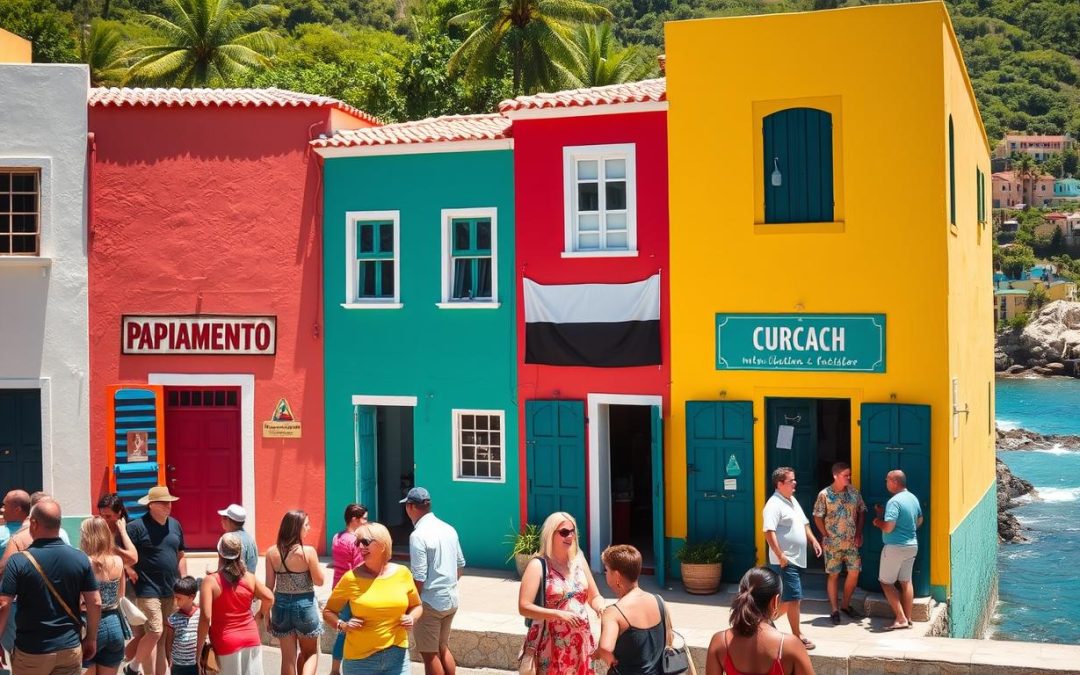Have you ever wondered how a small Caribbean island manages to weave together a linguistic tapestry that spans four distinct languages? Curaçao stands as a vibrant testament to linguistic diversity, where communication transcends traditional boundaries.
Nestled in the Caribbean, Curaçao represents a unique multilingual environment. Language here is more than just communication—it’s a living, breathing cultural expression. With just 171 square miles of land, this island hosts an incredible linguistic landscape that reflects its rich historical and cultural heritage.
The linguistic diversity of Curaçao is remarkable. While Dutch remains the official language, Papiamentu emerges as the true heart of local communication, spoken by approximately 82% of the population. English and Spanish complement this linguistic mix, creating a dynamic communication ecosystem that mirrors the island’s complex cultural roots.
Key Takeaways
- Curaçao embraces a truly multilingual society with four primary languages
- Papiamentu dominates as the primary spoken language, representing local identity
- The island’s linguistic diversity reflects its rich historical background
- Dutch remains the official administrative language
- Over 70% of residents can communicate in multiple languages
Understanding Curacao’s Linguistic Landscape
Curacao has a rich mix of languages that show its cultural heritage. The island’s language patterns are unique. They tell a story of history and cultural strength.
Papiamentu is at the core of Curacao’s language identity. It’s an Afro-Caribbean language. It shows the island’s complex history.
The Island’s Polyglot Society
Curacao’s language scene is very diverse. People easily switch between languages. This makes communication lively.
- Papiamentu (primary language for 81.2% of residents)
- Dutch (official administrative language)
- Spanish (regional influence)
- English (critical for tourism and business)
Language Distribution Demographics
The language spread on the island is interesting. Bilingualism is common. Schools teach both Dutch and Papiamentu.
Cultural Impact of Multilingualism
“Language is the road map of a culture. It tells you where its people come from and where they are going.” – Rita Mae Brown
This multilingual setting deeply influences Curacao’s culture. It shapes daily talks and art. It celebrates diversity and history.
| Language | Usage Context | Percentage of Speakers |
|---|---|---|
| Papiamentu | Daily Communication | 81.2% |
| Dutch | Official/Administrative | 100% (Formal Settings) |
| English | Tourism/Business | 65% |
| Spanish | Regional Interaction | 45% |
Exploring Curacao’s language scene shows a society that adapts and grows. Languages blend and make a unique communication world.
Historical Evolution of Languages in Curacao
Explore the rich language history of Curacao. This island’s language mix started with the Arawak people, long before Europeans arrived.
- 15th Century: Spanish explorers first introduced European language influences
- 17th Century: Dutch colonization established formal administrative language systems
- African Slave Trade Era: Multiple African languages dramatically reshaped linguistic development
“Languages are the roadmaps of a culture. They tell you where its people come from and where they are going.” – Rita Mae Brown
Papiamentu is a special language that came out of this time. It mixes:
- Portuguese roots
- Dutch words for government
- Spanish ways of talking
- African sounds and ways of speaking
| Historical Period | Language Influence | Key Developments |
|---|---|---|
| Pre-Colonial | Arawak Languages | Indigenous communication systems |
| 15th-17th Century | Spanish | Initial European language contact |
| 17th-19th Century | Dutch | Colonial administrative language |
The language mix in Curacao shows its complex past. Each language brought new cultural ideas. This created a society that values many languages and ways of talking.
Dutch: The Administrative Backbone
In Curacao, the Dutch language is key for official talks and laws. It’s at the heart of the island’s rules and systems. Knowing Dutch is the first step to grasp Curacao’s language world.
The Dutch language policy affects many parts of Curacaoan life. It shapes how the government works, schools teach, and businesses talk.
Role in Government and Legal Proceedings
Dutch is the only language for:
- Legislative documents
- Court proceedings
- Official government communications
- Judicial record-keeping
Educational System Language
Most schools in Curacao teach in Dutch. Students learn deeply in Dutch. This makes Dutch very important.
“Language is the roadmap of a culture. It tells you where its people come from and where they are going.” – Rita Mae Brown
Business and Official Communications
In work, Dutch is the norm for:
- Corporate documentation
- Official contracts
- International business correspondence
- Government tender processes
Knowing Dutch is key for work and business in Curacao.
Papiamentu: The Heart of Local Identity
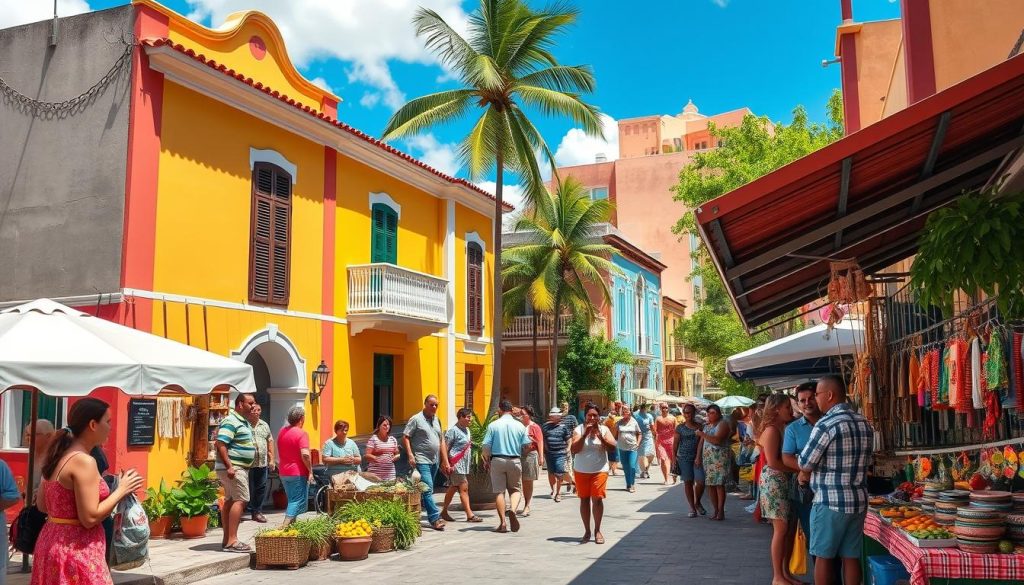
Explore the lively world of Papiamentu, a key Afro-Caribbean language in Curaçao. It’s not just words; it’s a symbol of the island’s rich culture. With about 350,000 speakers, it ties past and present together.
Papiamentu’s roots are as varied as Curaçao itself. It mixes Portuguese, Spanish, Dutch, African, and Arawakan influences. This blend makes up about 70% of its vocabulary, showing the island’s complex history.
“Dushi” – a beloved Papiamentu word that embodies the spirit of something delightful and cherished.
Key Characteristics of Papiamentu
- Official language in Aruba, Bonaire, and Curaçao
- Subject-Verb-Object (SVO) sentence structure
- Primarily an oral language until recent written documentation
- First printed book: Catecismo Corticu in 1837
- First newspaper: Civilisadó in 1871
When you hear Papiamentu, you’re seeing more than just talk. It’s a living cultural display. This language brings people together, showing pride and unity in Curaçao.
| Language Aspect | Details |
|---|---|
| Native Speakers | 350,000 (2001-2024) |
| Official Status | Official in Aruba, Bonaire, Curaçao |
| Vocabulary Origin | 70% Portuguese and Spanish |
| Language Code | ISO 639-2: pap |
Dive into Papiamentu, and you’ll find more than just words. It’s a celebration of Curaçao’s spirit and diverse identity.
Curacao: Official and Widely Spoken Languages
Curacao’s language scene is a colorful mix of communication. It shows the island’s rich cultural background. With over 150,000 people, the island values speaking many languages.
Status and Recognition
The island officially recognizes three languages. This makes Curacao’s language policy special. It celebrates the diversity of its people.
- Papiamentu
- Dutch
- English
Language Policy Development
Curacao’s language policy has grown to support its diverse culture. The government has worked hard. They aim to keep language diversity while making sure everyone can communicate well.
“Language is the road map of a culture. It tells you where its people come from and where they are going.” – Rita Mae Brown
Public Usage Guidelines
These languages are used in many areas of life. You’ll see them in:
- Government communications
- Educational institutions
- Business interactions
- Media and entertainment
Interestingly, 62.4% of the population speaks English. Also, 21.1% speak Dutch. This shows Curacao’s effort to be open and connected to the world.
Spanish Influence and Regional Connections
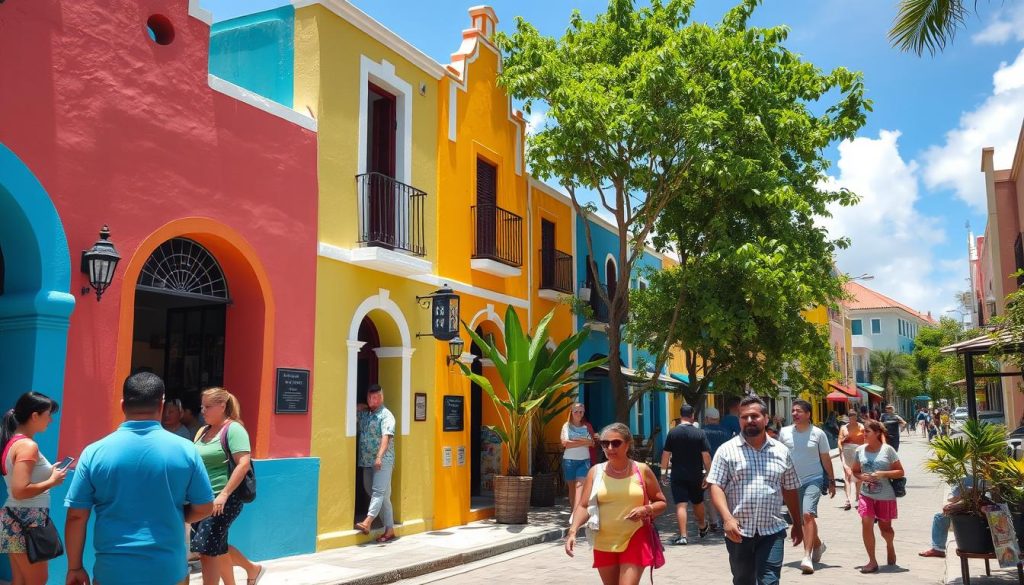
Curacao’s language scene is rich because of its ties with Spanish-speaking countries. The island’s mix of languages shows the deep cultural ties with Venezuela and Colombia. Spanish became important in the 18th century, thanks to strong economic links and close geography.
Knowing about Curacao’s Spanish roots is key to understanding its language scene. Venezuelan TV shows reach homes in Curacao, linking communities across seas.
- Spanish is a key way to communicate
- Local media boosts cultural ties
- Trade helps grow language use
Knowing Spanish in Curacao has big benefits. It opens doors to more chances in the Caribbean and Latin America. This skill is useful in business and social life.
“Language is the roadmap of a culture. It tells you where its people come from and where they are going.” – Rita Mae Brown
Curacao’s love for Spanish shows how language diversity makes a community richer. Every conversation shows the island’s connected identity, linking pasts and making new stories.
English in Modern Curacao
English is becoming more important in Curacao, linking the island to the world. It’s not the main language but plays a big role in many areas of life.
Tourism and International Business
English is key for connecting with the world in Curacao. The tourism industry needs English to welcome visitors from everywhere. About 2% of the people are expats who mostly speak English, making the place lively and international.
- Hotels and resorts prioritize English communication
- Tourism sector depends on multilingual interactions
- International businesses favor English competence
Media and Entertainment
English media shapes Curacao’s entertainment scene. From movies to music, English content fills local media. This helps locals learn more English, opening up new language education chances.
| Media Platform | English Influence |
|---|---|
| Television | 70% English-language programming |
| Online Streaming | 90% international content |
| Radio | 45% English music rotation |
Educational Opportunities
English is crucial for students and workers in Curacao. Schools focus more on English, seeing its value for global careers. Most people speak at least two languages, with English being key.
“Language is the road map of a culture. It tells you where its people come from and where they are going.” – Rita Mae Brown
By adopting English, Curacao grows as a multilingual center. It connects local culture with global communication.
Language Education and Learning Resources
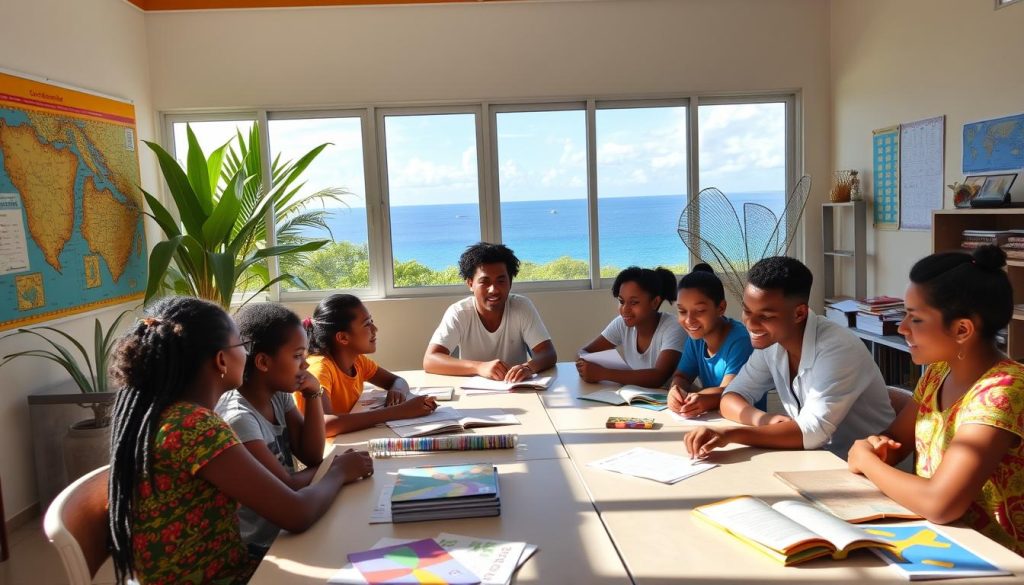
Curaçao has a rich language education scene, showing its diverse culture. The island’s schools focus on teaching many languages. This prepares students for talking with people all over the world.
At the International School of Curaçao (ISC), learning languages is key. The school has a wide range of languages, with:
- Approximately 20 languages represented in the student body
- 20% of students being native English speakers
- Comprehensive language preservation strategies
The Dutch language curriculum is especially interesting. Students start learning Dutch in grade 2. They follow two paths:
- R2/Native Pathway: For students fluent in Dutch
- R3/Non-Native Pathway: For students learning Dutch as a foreign language
“Language is the roadmap of a culture. It tells you where its people come from and where they are going.” – Rita Mae Brown
Curaçao is dedicated to keeping languages alive. The CNaVT exam lets students show their Dutch skills. They can prove they know Dutch at levels like Maatschappelijk Informeel (A2 level) and Maatschappelijk Formeel.
For those interested in language, Curaçao is a great place. About 80% of people speak Papiamentu first. The schools make sure this language stays alive and easy to learn.
Whether you’re a student, worker, or just love languages, Curaçao is perfect. It’s a great place to learn and dive into different cultures.
Cultural Expression Through Multiple Languages
Curacao’s mix of languages brings culture to life in many ways. The island’s unique mix of languages adds color to arts, literature, media, and online spaces. It shows off the rich Afro-Caribbean languages that shape its identity.
Arts and Literature: A Multilingual Tapestry
Exploring Curacao’s culture, you find a rich mix of languages. Artists and writers blend Papiamentu, Dutch, Spanish, and English. They create stories that show the island’s rich history.
- Poetry slams featuring Papiamentu rhythms
- Novels blending Caribbean perspectives with multiple language influences
- Theater productions that celebrate linguistic creativity
Media and Entertainment: Language in Action
Local media shows Curacao’s language skills. You’ll hear conversations that easily switch between languages. This highlights the island’s special way of talking.
“Language is the road map of a culture. It tells you where its people come from and where they are going.” – Rita Mae Brown
Social Media Communication: Digital Linguistic Playground
Young people in Curacao make social media a lively place for languages. They mix Afro-Caribbean languages with global trends. This creates a unique online identity that shows their diverse background.
- Instagram posts mixing language codes
- Twitter conversations jumping between languages
- TikTok content celebrating linguistic creativity
Curacao shows how language diversity is more than words. It’s about pride, creativity, and connection.
Language Preservation Efforts
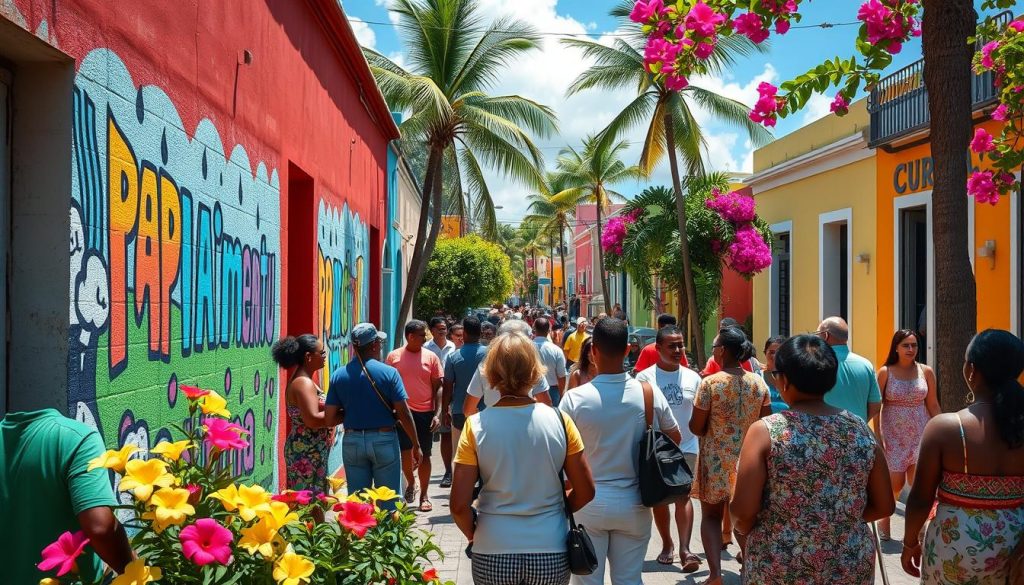
Curacao is dedicated to keeping its language alive. The Papiamentu language is at the heart of the island’s culture. It’s more than just a way to talk; it’s the community’s spirit.
There are big efforts to save and celebrate this special language. Some key actions include:
- Developing comprehensive educational programs
- Creating media content in Papiamentu
- Documenting linguistic nuances
- Supporting community language initiatives
“Language is the roadmap of a culture. It tells you where its people come from and where they are going.” – Rita Mae Brown
Statistics show how vital these efforts are. With 83.2 percent of people speaking Papiamentu, it’s a key part of their identity.
| Preservation Initiative | Impact |
|---|---|
| Primary School Instruction | Papiamentu taught 2.5 hours weekly |
| Language Documentation | Tracking linguistic evolution |
| Media Representation | Increasing visibility of Papiamentu |
Understanding language preservation is more than just learning. It’s about keeping a culture alive. It connects people across generations and celebrates Curacao’s unique language.
Conclusion
Your journey through Curacao’s language shows its cultural strength. This small island is a hub of language diversity. People here easily switch between Papiamentu, Dutch, Spanish, and English.
Curacao’s language mix shows how to connect past and present. It proves that language can unite people, making society vibrant and connected.
Curacao’s language goes beyond talking. It’s a part of the island’s history, from Papiamentu’s Creole roots to Dutch’s role in governance. Over 80% speak Papiamentu at home, and most are fluent in more than one language. This makes Curacao a unique example of language harmony.
Language in Curacao is a living part of culture. It shapes tourism, education, and everyday life. The island’s language diversity shows its flexibility and openness.
As global communication grows, Curacao inspires us. It shows how different languages can live together, enhancing community and cultural identity.
The above is subject to change.
Check back often to TRAVEL.COM for the latest travel tips and deals.
Here are some Tours & Sightseeing suggestions that might pique your interests!
